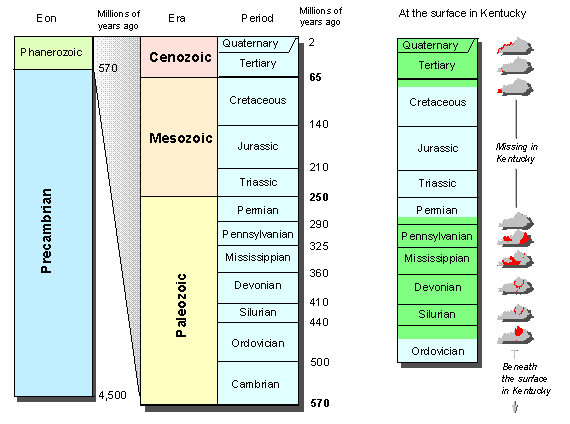

KGS Home > Geology of Kentucky
Geologic Time
This chart is a geologic timescale. The chart shows the name of the ages and the time in millions of years in which it began and ended.

Geologists have subdivided the 4.5-billion-year history of the earth into two dominant eons: the Precambrian and the Phanerozoic. The Precambrian represents most of the earth's history up till the last 550 million years; the Phanerozoic covers from 550 million years ago to the present. Most of the fossils found on earth are Phanerozoic. The Phanerozoic is divided into three eras: the Paleozoic (550 to 250 million years ago), the Mesozoic (250 to 65 million years ago), and the Cenozoic (65 million years ago to the present). The Paleozoic has been called the Age of Invertebrates because of the rapid development of invertebrate animals during that time. Invertebrate animals (animals without backbones) lived before the Paleozoic and are still the most abundant animal life on Earth. The Mesozoic Era is sometimes called the Age of Dinosaurs because the dinosaurs lived entirely within the Mesozoic. However, the first dinosaurs were not present till several million years after the start of the Mesozoic. The Cenozoic is commonly called the Age of Mammals because of the rapid rise of mammals after the extinction of the dinosaurs. The first mammal-like animals were actually present during the later stages of the Paleozoic.
The Paleozoic Era is divided into the following ages: Cambrian (550 to 510 million years ago), Ordovician (510 to 440 million years ago), Silurian (440 to 410 million years ago), Devonian (410 to 360 million years ago, Mississippian (360 to 325 million years ago), Pennsylvanian (325 to 290 million years ago), and the Permian (290 to 250 million years ago).
The Mesozoic Era is divided into the following ages: Triassic (250 to 205 million years ago), Jurassic (205 to 140 million years ago), and the Cretaceous (140 to 65 million years ago).
The Cenozoic Era is divided into the following ages: Paleogene (65 to 23 million years ago), Neogene (23 to 1.6 million years ago), and Quaternary (1.6 million years ago to the present). The combined Paleogene and Neogene are sometimes refered to as the Tertiary.
Links to see where the continents were in the past.
Links to important times in earth history.
Back to Earth Science Education Network